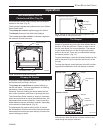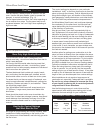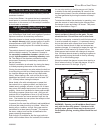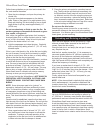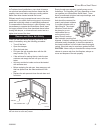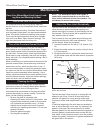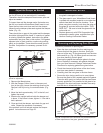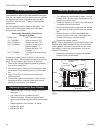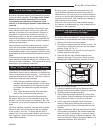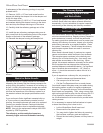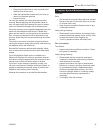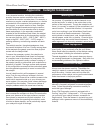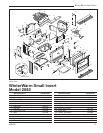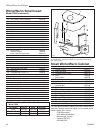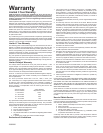
20
WinterWarm Small Insert
2000888
Appendix: Catalytic Combustor
In any chemical reaction, including the combustion
process, there are certain conditions which must be
met before the reaction can take place. For example, a
reaction may require a certain temperature, or a certain
concentration of the reactants (the combustion gases
and oxygen), or a certain amount of time. Catalysts,
though not changed themselves during the reaction,
have the ability to act at a molecular level to change
these requirements. In the secondary combustion
chamber of the WinterWarm Small Insert, the catalyst
reduces the temperature at which secondary combus-
tion can start from the 1000° - 1200°F (540° - 650°C)
range to the 500° - 600°F (260° - 315°C) range, in-
creasing efficiency, and reducing creosote and emis-
sions.
The catalytic reaction, though advantageous, does
have some limitations of its own. Primary among these
is the reactants (the gases) come into close physical
contact with the catalyst itself.
To ensure the necessary contact, the catalytic ele-
ment in your WinterWarm Small Insert is composed
of a ceramic base in the shape of a honeycomb. On
each of the honeycomb’s many surfaces a coating of
the catalyst (usually a noble metal such as platinum or
palladium) is applied. The large surface area exposed
in this configuration ensures that the combustion gases
have the greatest opportunity to come in contact with
the catalyst.
Loss of catalytic activity will be apparent in several
ways. First you may notice an increase in fuel con-
sumption. Second, there will be a visible increase in the
rate at which creosote builds up in your chimney con-
nector system. You may also notice a heavy discharge
of smoke from the chimney. There are a number of
catalytic problems which can cause loss of activity:
Blockage
While the honeycomb pattern ensures good contact, it
also increases the resistance to flow of the combustion
gases, and, because of the many surfaces, provides
more places for creosote and fly ash to deposit. It is
important to follow the operating instructions in order
to minimize these deposits, and to periodically inspect
your catalyst for signs of blockage.
Masking and Poisoning
While the catalyst itself does not enter into the combus-
tion process, it is possible for certain elements, such
as lead and sulfur, to attach to the active sites on the
surface of the honeycomb. Though the catalyst is still
there, it is covered, or masked, by the contaminant, and
cannot function. To avoid this situation, it is important
not to burn anything in your WinterWarm Small Insert
that is a source of these contaminants. Particularly
avoid painted or treated wood, coal, household trash,
colored papers, metal foils, or plastics. Chemical chim-
ney cleaners may also contain harmful elements. The
safest approach is to burn only untreated, natural wood.
Flame Impingement
The catalytic element is not designed for exposure to
direct flame. If you continually over-fire your Winter-
Warm Small Insert the chemistry of the catalyst coating
may be altered, inhibiting the combustion process.
Thermal degradation of the ceramic base may also oc-
cur, causing the element to disintegrate. Stay within the
recommended guidelines of the Operation section.
Mechanical Damage
If the element is mishandled, damage may occur.
Always treat the element carefully. Remember the
catalyst is made of a ceramic material; treat it as you
would fine china. Hairline cracks will not affect the
performance of the catalyst, as long as the steel sleeve
holds the element in the proper position.
Peeling
Peeling of the surface coat may occur if the catalytic
element is frequently subjected to excessive tempera-
tures. Follow the operating instructions carefully to
avoid this type of damage.
Every CFM Corporation product is equipped with a
Corning “Long-Life”
®
“Honeycomb”
®
. If for any reason
you must ship your catalytic element, remember its
fragile nature. Place the element in a plastic bag, and
package it with a generous amount of shock absorbing
material.



